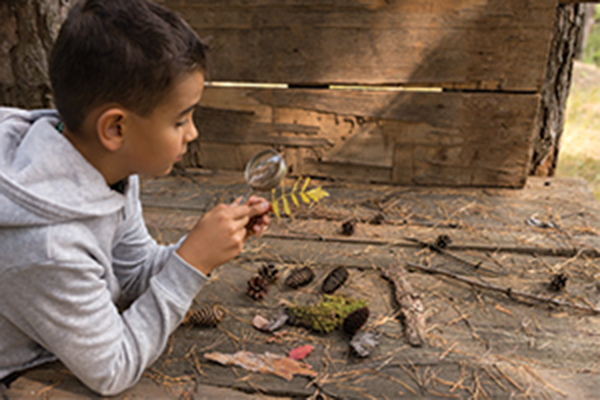Discovery Journeys from Developing Appropriate Curriculum for Young Children
Why aren’t kids outside anymore?
Over the last several years, many studies and articles have detailed how children need—and often don’t get enough—time outside, resulting in a nature-deficit disorder. Experts have expressed concern about the nature-deficit disorder because it can harm a child’s grades, health, and wellbeing.
Key causes include:
- The loss of natural surroundings in a child’s neighborhood—outdoor spaces where they can build forts, run, play with other children, and design games
- Parents' fear of risking their child’s safety by being outside the home
- Increased use and appeal of technology for entertainment (Alexander, 413).
How can educators address nature-deficit disorder?
One strategy to encourage outside play is to use Discovery Journeys with future early childhood educators. Developing Appropriate Curriculum for Young Children by Nancy Alexander includes “Discovery Journeys,” which are features that highlight experiences early childhood educators have had that inspire them to develop their own teaching philosophy. Providing examples of what an educator may see in their community or remember from their own childhood encourages self-reflection and connections to students’ lives and future workplaces. Each Discovery Journey is a narrative that is fun to read and is followed by critical-thinking questions that help students consider how they can apply these kinds of play in the classroom.
Here are some examples:
Discovery Journey 1: Fort Building
“The Neighborhood Fort” Discovery Journey describes an educator who notices a small fort on a vacant lot on their walk to work:
“At first, the “fort” was just a stacked pile of small tree trunks about 4–5 feet tall. As the weeks passed, branches were added to make a roof. I noticed changes to the fort mostly on Mondays, leading me to infer that children were doing this work over the weekends.
I was fascinated to see the fort built, rebuilt, and becoming more complex. One Saturday afternoon, I passed the lot and noticed several school-age children working on it. I parked my car, walked over to them, told them I was a teacher at the local school, and was interested in what they were building. They were happy to let me look inside, where they had set up beanbag chairs, a rug, and a makeshift table. One explained they had brought the logs from a construction site about five blocks away, describing how hard it was to drag them so far. They explained how it took three of them to transport a log until they realized they could pull them on wagons” (Alexander, 418).
Over time, the teacher sees the fort fall apart, the lot get sold, and a new home built upon it. Even many years later, they think, “...I am a bit saddened as the availability of vacant lots diminishes in areas where children are growing up and opportunities for such experiences concurrently diminish” (418).
Integrate this Discovery Story into the Classroom:
- Ask students to reflect on a time they built a fort, tree house, or other structure with children outside in their neighborhood.
- As a class, discuss the benefits of this kind of activity outdoors, compared to a pillow fort or similar activity indoors.
- Have students develop ideas for similar experiences they could offer on a playground.
Discovery Journey 2: Fishing
“Fishing with my Father” Discovery Journey by Dr. Sandra Duncan describes memories of her favorite activity with her father on a small freshwater lake in Michigan:
 “My dad told me all about the secret to catching fish. It was to watch for ripples to form around the plastic bobber, and this was the precursor to a fish bite. He taught me how to bait and take a fish off the hook, and even how to fry up the day’s catch in a big cast iron skillet over an open campfire. But, in those long-ago days of fishing with my dad, I think he taught me far more lessons than just how to watch the red and white plastic bobber. In those special fishing moments, he taught me important lessons about the ways of life.
“My dad told me all about the secret to catching fish. It was to watch for ripples to form around the plastic bobber, and this was the precursor to a fish bite. He taught me how to bait and take a fish off the hook, and even how to fry up the day’s catch in a big cast iron skillet over an open campfire. But, in those long-ago days of fishing with my dad, I think he taught me far more lessons than just how to watch the red and white plastic bobber. In those special fishing moments, he taught me important lessons about the ways of life.
One life lesson my dad taught me was that patience doesn’t always work. With fishing, you can sometimes wait…wait…and wait until your eyes cross, but your patience doesn’t always reward you with a fish. And that’s a good lesson. Even great work doesn’t aways have a reward at the end of the day. Sometimes you can give your best effort and still not get the results you were hoping for. With age, I have come to realize that your best efforts are oftentimes rewarded on more of a personal and internal level rather than with confetti and cheers from others” (Alexander, 443).
Integrate this Discovery Story into the Classroom:
- Ask students to consider how being outdoors with family creates lifelong memories.
- Discuss as a class how early childhood educators can encourage families to enjoy activities outside together.
- Have students develop ideas for similar ‘fishing” experiences they could offer on a playground.
______________________________________________________________________
Explore many more discovery journeys by requesting a free preview of Developmentally Appropriate Curriculum for Young Children. Other new ECE resources that are current, authentic, and aligned to NAEYC and DAP standards are now available from G-W, providing a perfect blend of theory and application with a focus on real-world relevance.
Further reading:
Developmentally Appropriate Curriculum for Young Children, by Nancy Alexander.
www.g-w.com/developing-appropriate-curriculum-for-young-children-2025.
What is Nature Deficit Disorder? by Richard Louv
Children’s Time Outdoors: Results and Implications of the National Kids Survey, by Larson, Green, and Cordell, “The Journal of Park and Recreation Administration”
All Kids Need Time in Nature and the Planet Needs That Too, by Jesica Schrader, “Psychology Today”
Children’s Special Places: Exploring the Role of Forts, Dens, and Bush Houses in Middle Childhood, by David Sobel
The Honeycomb Hypothesis: How Infants, Toddlers, and Two-Year-Olds Learn Through Nature Play, by Dr. Sandra Duncan.





